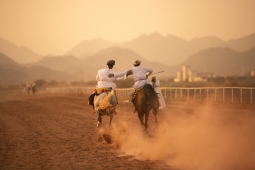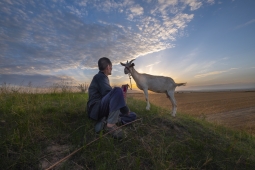Did You Know? The City of Balkh: Ancient Capital of Bactria and Centre of Buddhism and Zoroastrianism along the Silk Roads
Mountains in the Province of Balkh on the Ancient Silk Roads © Mushtaq B/Shutterstock.comThe city of Balkh, situated on the plain between the Hindu Kush Mountain range and the Amu Darya river (the ‘Oxus’ in antiquity), in the north of modern day Afghanistan, sat at a cross-roads along the Silk Roads, with several trade routes intersecting in and around the city. From Balkh caravans could follow the well-watered foot of the mountains westward towards Herat and the Iranian Plateau, or across the Oxus to Samarkand and China. Dating back as far as 330 BCE, the city was an ancient centre of both Buddhism and Zoroastrianism two major religions which flourished thanks to movement and interactions along these routes.
Throughout its long history Balkh has been the capital of the ancient region of Bactria, a major city of Khorasan, and a prominent centre during the Abbasid period. Well resourced, the city sat on an alluvial fan (a large area of river sediment) suited to irrigation. The surrounding region was renowned for its grapes, oranges, water lilies, sugar cane, and an excellent breed of camel. Due to its position on the Silk Roads, at its height there were a considerable number of caravanserais in and around the city, many of them managed by groups of local merchants. From the Roman world caravans entering Balkh bought metal wares particularly gold and silver vessels, from Central Asia and China came rubies, furs, aromatic materials, and raw and embroidered silks. Goods from the Indian Subcontinent also reached Balkh including spices, cosmetics, ivory and precious stones, and gems. With the lands through which the caravans passed divided into a few stable states, Balkh owed its early stability to nearby settlements co-existing and cooperating in the interests of trade. As such Balkh flourished as a depot point for the world’s luxuries.
Furthermore, for a long period of time Bactria was a centre of Zoroastrianism, and Zoroaster is said to have taught in the city, perhaps in the 6th century BCE. Balkh is also known as one of the birthplaces of Nowruz. Celebrations in Balkh of the Persian/Iranian new year rite observed by diverse groups in many regions along the Silk Roads on the Spring Equinox date back around 3000 years. Notably, monks and religious followers often travelled with merchants and with them came the new religion of Buddhism. Indeed, after Balkh was visited by two prominent Buddhist monks, stupas, convents, and monuments were built across the city which became famous for its temples and monasteries, and as a centre for worship and teaching attested to in accounts from the 7th century CE. It was also a thriving centre for Manicheism, with evidence of Hindu and Christian communities residing in the city as well. Subsequent later accounts from the 10th century CE indicate that the city was ringed by an earthen wall within which was built a fine citadel and mosque.
As a result of high levels of inter-connectivity, craftsmanship and trade flourished in Balkh, as did theology, philosophy, and the arts, and the city featured prominently in the accounts of historians and travellers of the Silk Roads. Its reputation as a place of learning persisted, judging by accounts of travellers in the 12th century CE, who describe a range of educational establishments, as well as Balkh’s importance as a trading centre for the region, with links to the Indian Subcontinent and China. The 9th and 10th century geographers of the Islamic Golden Age Ya’qubi (d.897/8 CE) and Moqaddasi (d.991 CE) describe Balkh as a large and prosperous city some three square miles in area with a population of perhaps close to 200,000 people. By this time a large Friday Mosque occupied the city centre, with many more mosques scattered among the dwellings, whilst the fire temple, formerly the Buddhist monastery admired by the Buddhist monk, scholar, and traveller from China, Xuanzang (602 – 604 CE), was still notable.
We may sometimes be tempted to think of highly pluralistic and cosmopolitan cities as a relatively recent phenomena, however cities located at the cross-roads of Silk Roads routes attest to a much longer history of exchange, cultural interaction, and plural identities. Thanks to its advantageous location on the Silk Roads, Balkh became a prosperous city, a home to communities from the Iranian Plateau, Anatolia, and the Indian Subcontinent, a centre of Buddhism and Zoroastrianism, as well as a hub for philosophy and the arts. Although a much smaller settlement can be found in the location today, historic Balkh’s diverse cultural influences continue to be reflected in its contemporary life.
See Also

Traditional Horseback Games and Equestrian Sports along the Silk Roads
Animals played an essential role in the exchange and interactions taking place along the Silk Roads. Whilst sheep and goats provided many people with the commodities of daily life, camels and horses were crucial to travel, exploration, and the development of mercantile relations between peoples.







